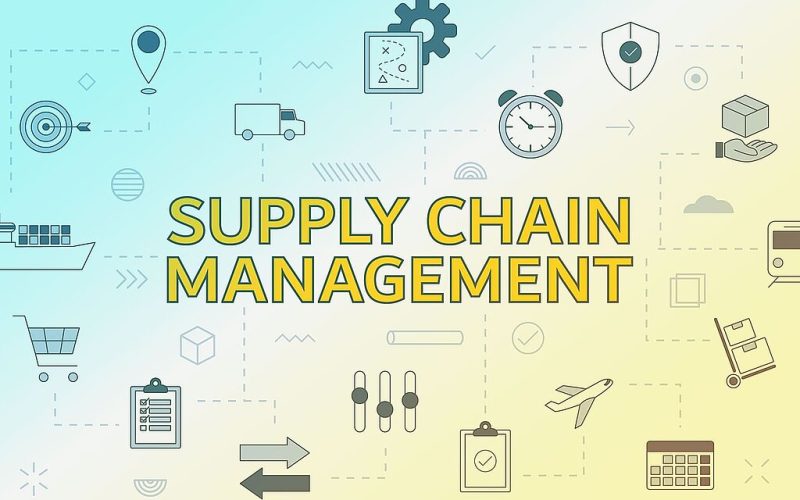In today’s competitive business landscape, Supply Chain Management (SCM) has emerged as a critical component in delivering customer satisfaction, optimizing resources, and driving growth. Effective SCM ensures that each link in the supply chain—from suppliers to customers—operates in harmony, fostering efficiency and adaptability.
This article dives into the benefits, key components, and real-world applications of SCM, exploring how companies like Walmart and Proctor & Gamble leverage SCM strategies to remain leaders in their fields.
What is Supply Chain Management?

Supply Chain Management (SCM) refers to the planning, coordination, and management of all activities involved in sourcing, production, and logistics to deliver goods or services to customers. The supply chain itself is a network of suppliers, manufacturers, warehouses, and distributors that work together to ensure that a product or service is delivered to the customer in the most efficient way possible.
SCM is not only about managing resources within a company but also includes external partners. By integrating suppliers, manufacturers, and distribution channels, companies can align operations with customer demand and ultimately provide a seamless experience.
Key Components of SCM
Supply Chain Management can be broken down into five essential components:
- Planning: This involves forecasting demand, identifying resources, and establishing metrics to evaluate supply chain performance.
- Sourcing: The selection and management of suppliers, negotiating contracts, and overseeing supplier relationships to ensure timely and high-quality deliveries.
- Making: The actual production process, which includes quality testing, packaging, and ensuring productivity standards are met.
- Delivering: This covers logistics, including order fulfillment, transportation, and invoicing, ensuring the product reaches the customer efficiently.
- Returning: Managing product returns, handling defective products, and ensuring customer satisfaction with the return process.
Each of these components contributes to creating a supply chain that meets customer demands effectively.
Benefits of Effective Supply Chain Management
Implementing an efficient supply chain system brings numerous benefits that help companies optimize resources, reduce costs, and enhance customer satisfaction. Below are some of the most notable advantages:
- Lowered Costs: Efficient SCM reduces operating costs by streamlining processes. For instance, avoiding overproduction helps to cut down labor and raw material costs, while just-in-time delivery minimizes warehousing expenses.
- Increased Revenue: By closely aligning with customer demand, companies can keep products available on the shelves, leading to higher sales and customer satisfaction.
- Improved Inventory Management: Effective SCM allows for better control over inventory levels, minimizing excess stock and reducing storage costs. This leads to an optimized supply chain where products are readily available without overstocking.
- Asset Utilization: By managing production schedules and equipment usage, companies can avoid wear and tear on machinery and maximize asset utilization, prolonging the life of expensive assets.
- Enhanced Customer Satisfaction: SCM allows businesses to deliver products accurately and quickly, improving overall customer satisfaction and loyalty. A well-coordinated supply chain ensures customers receive what they want, when they want it, in the condition they expect.
The Role of Technology in Supply Chain Management

With advances in technology, SCM has evolved beyond traditional practices. Real-time communication is one of the most significant changes, enabling companies to respond promptly to demand fluctuations. Additionally, tools like blockchain enhance transparency, while artificial intelligence helps in predictive analysis and demand forecasting.
In recent years, technology has allowed companies to automate various aspects of SCM, such as tracking shipments, managing inventory, and processing invoices. Automation reduces manual errors and allows SCM professionals to focus on strategic decision-making, ultimately enhancing productivity.
Real-World Examples of Supply Chain Management
To understand the power of SCM, let’s look at two industry giants: Walmart and Proctor & Gamble.
Walmart and Proctor & Gamble: A Seamless Integration
In the late 1980s, Walmart and Proctor & Gamble (P&G) joined forces to integrate their supply chains, leading to a revolutionary partnership that continues today. The companies connected their systems to share real-time data on inventory levels and sales, allowing Walmart to keep its shelves stocked without holding excessive inventory.
When a Walmart store’s inventory of P&G products drops below a set threshold, the system automatically notifies P&G’s distribution center to ship additional products. This automated communication ensures that Walmart’s shelves are never empty, maximizing sales opportunities while minimizing stock-outs.
This integration benefited both companies, lowering operating costs, reducing stockouts, and ensuring timely delivery. The constant exchange of information has set a standard for supply chain efficiency and helped establish Walmart and P&G as leaders in their respective industries.
Case Study: Amazon’s Pioneering Supply Chain Management
Amazon, the global e-commerce giant, is renowned for its sophisticated supply chain management, allowing it to offer fast delivery and an extensive product range. By utilizing an innovative mix of logistics, technology, and customer-centric strategy, Amazon has transformed SCM into a science.
- Advanced Warehousing and Inventory Management: Amazon operates a network of massive, technology-driven warehouses that use automation to sort, pick, and package products. This allows Amazon to process millions of orders quickly, ensuring items are ready for dispatch within hours of the customer placing an order.
- Delivery Optimization: Amazon’s fleet of delivery vehicles and partnerships with local delivery providers enables same-day or next-day delivery in many areas. Amazon has even ventured into drone delivery, further enhancing its logistics capabilities.
- Predictive Analytics: By analyzing customer purchase patterns, Amazon can anticipate what items customers might order next. This allows Amazon to pre-position inventory in warehouses closest to potential demand, further reducing delivery times.
Amazon’s relentless focus on SCM has enabled it to offer superior service, quickly respond to customer demand, and dominate the e-commerce space globally.
How Supply Chain Management Drives Competitive Advantage
In an increasingly globalized economy, businesses that optimize their supply chains gain a competitive edge. Companies like Toyota and Apple have leveraged SCM to enhance customer satisfaction and minimize costs.
Toyota’s Lean Manufacturing Approach

Toyota is well-known for its lean manufacturing approach, where it carefully manages inventory levels to minimize waste and reduce costs. By producing vehicles based on real-time customer demand, Toyota avoids excess inventory and unnecessary expenses.
Toyota’s SCM strategy also involves close collaboration with suppliers to ensure quality and reliability. Through frequent communication and monitoring, Toyota can identify and resolve any issues early in the supply chain, reducing delays and enhancing product quality.
This approach has not only helped Toyota lower costs but has also established it as one of the most reliable car manufacturers in the world.
Apple’s Supplier Relationship Management
Apple is recognized for its meticulous control over its supply chain, particularly when it comes to supplier relationships. By maintaining close ties with suppliers, Apple can secure high-quality materials, ensuring that its products meet strict standards.
Apple also coordinates its supply chain to minimize the time between production and customer delivery. For instance, the company’s “just-in-time” manufacturing model allows it to produce products as orders come in, reducing waste and maintaining lean inventory levels.
By focusing on quality control and delivery speed, Apple has set itself apart in the technology market, creating loyal customers who trust its products’ reliability and performance.
The Future of Supply Chain Management
As supply chains become more complex, the role of technology will continue to grow. Emerging technologies such as blockchain, artificial intelligence, and the Internet of Things (IoT) promise to reshape SCM.
- Blockchain: Blockchain technology enhances transparency by providing a secure, immutable record of every transaction. This can improve trust between supply chain partners and provide customers with accurate information about a product’s origin.
- Artificial Intelligence: AI can help with predictive analytics, enabling companies to forecast demand more accurately and optimize resources. AI-driven insights can also help in identifying supply chain bottlenecks and improving inventory management.
- IoT: The Internet of Things allows for real-time monitoring of inventory, shipments, and equipment. Sensors can alert managers of potential issues before they escalate, reducing downtime and improving supply chain efficiency.
These technologies will allow supply chains to become more agile and responsive, enabling companies to adjust quickly to changing market conditions.
Final Thought
Supply Chain Management is essential for businesses looking to compete in today’s market. Effective SCM can reduce costs, increase revenue, and improve customer satisfaction. Companies like Walmart, Amazon, Toyota, and Apple have demonstrated that a well-managed supply chain can provide a significant competitive advantage, leading to stronger customer loyalty and improved profitability.
By leveraging technology, maintaining close relationships with suppliers, and focusing on efficiency, businesses can develop a resilient supply chain that supports growth and adapts to changing demands. As technology continues to evolve, the future of SCM promises even greater efficiency and effectiveness, positioning businesses to succeed in an increasingly dynamic global economy.










